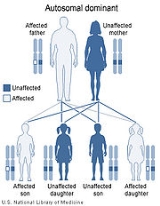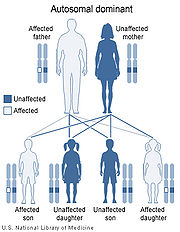
Saethre-Chotzen syndrome
Encyclopedia
Saethre-Chotzen syndrome (SCS), also known as acrocephalosyndactyly type 3 (ACS III) and Chotzen syndrome, is a very rare autosomal
dominant congenital disorder
characterized by acrocephalosyndactyly, craniosynostosis
(premature closure of one or more of the sutures between the bones of the skull
). It is caused by mutations in the TWIST transcription factor
(TWIST) gene.
 SCS is caused by a mutation in the TWIST gene, located on human chromosome
SCS is caused by a mutation in the TWIST gene, located on human chromosome
7p21
. Autosomal dominant inheritance indicates that the defective gene responsible for a disorder is located on an autosome
(chromosome 7 is an autosome), and only one copy of the gene is sufficient to cause the disorder, when inherited from a parent who has the disorder.
Autosome
An autosome is a chromosome that is not a sex chromosome, or allosome; that is to say, there is an equal number of copies of the chromosome in males and females. For example, in humans, there are 22 pairs of autosomes. In addition to autosomes, there are sex chromosomes, to be specific: X and Y...
dominant congenital disorder
Congenital disorder
A congenital disorder, or congenital disease, is a condition existing at birth and often before birth, or that develops during the first month of life , regardless of causation...
characterized by acrocephalosyndactyly, craniosynostosis
Craniosynostosis
Craniosynostosis is a condition in which one or more of the fibrous sutures in an infant skull prematurely fuses by ossification, thereby changing the growth pattern of the skull...
(premature closure of one or more of the sutures between the bones of the skull
Human skull
The human skull is a bony structure, skeleton, that is in the human head and which supports the structures of the face and forms a cavity for the brain.In humans, the adult skull is normally made up of 22 bones...
). It is caused by mutations in the TWIST transcription factor
Twist transcription factor
Twist transcription factor is a basic-helix-loop-helix transcription factor associated with Saethre-Chotzen syndrome.-Interactions:Twist transcription factor has been shown to interact with EP300, TCF3 and PCAF.-External links:*...
(TWIST) gene.
Characteristics
Classic features include:- synostosisSynostosisSynostosis is the abnormal fusion of neighbor bones. It is a type of dysostosis.Examples of synostoses include: craniosynostosis- being an abnormal fusion of two or more cranial bones, radio-ulnar synostosis- being the abnormal fusion of the radius and ulna bones of the forearm, tarsal coalition -...
of the coronal sutureCoronal sutureThe coronal suture is a dense, fibrous connective tissue joint that separates the frontal and parietal bones of the skull. At birth, the bones of the skull do not meet.-Pathology:...
s of the skull resulting in characteristic faceFaceThe face is a central sense organ complex, for those animals that have one, normally on the ventral surface of the head, and can, depending on the definition in the human case, include the hair, forehead, eyebrow, eyelashes, eyes, nose, ears, cheeks, mouth, lips, philtrum, temple, teeth, skin, and...
s including ptosisPtosis (eyelid)Ptosis is a drooping of the upper or lower eyelid. The drooping may be worse after being awake longer, when the individual's muscles are tired. This condition is sometimes called "lazy eye", but that term normally refers to amblyopia...
, facial asymmetry and small ears - syndactylySyndactylySyndactyly is a condition wherein two or more digits are fused together. It occurs normally in some mammals, such as the siamang and kangaroo, but is an unusual condition in humans.-Classification:...
of the fingers, particularly of the second and third digits - Intelligence is usually normal. Some affected individuals may have mild to moderate mental retardationMental retardationMental retardation is a generalized disorder appearing before adulthood, characterized by significantly impaired cognitive functioning and deficits in two or more adaptive behaviors...
.
Cause and genetics

Chromosome
A chromosome is an organized structure of DNA and protein found in cells. It is a single piece of coiled DNA containing many genes, regulatory elements and other nucleotide sequences. Chromosomes also contain DNA-bound proteins, which serve to package the DNA and control its functions.Chromosomes...
7p21
Chromosome 7 (human)
Chromosome 7 is one of the 23 pairs of chromosomes in humans. People normally have two copies of this chromosome. Chromosome 7 spans more than 158 million base pairs and represents between 5 and 5.5 percent of the total DNA in cells.Identifying genes on each chromosome is an active area of genetic...
. Autosomal dominant inheritance indicates that the defective gene responsible for a disorder is located on an autosome
Autosome
An autosome is a chromosome that is not a sex chromosome, or allosome; that is to say, there is an equal number of copies of the chromosome in males and females. For example, in humans, there are 22 pairs of autosomes. In addition to autosomes, there are sex chromosomes, to be specific: X and Y...
(chromosome 7 is an autosome), and only one copy of the gene is sufficient to cause the disorder, when inherited from a parent who has the disorder.

